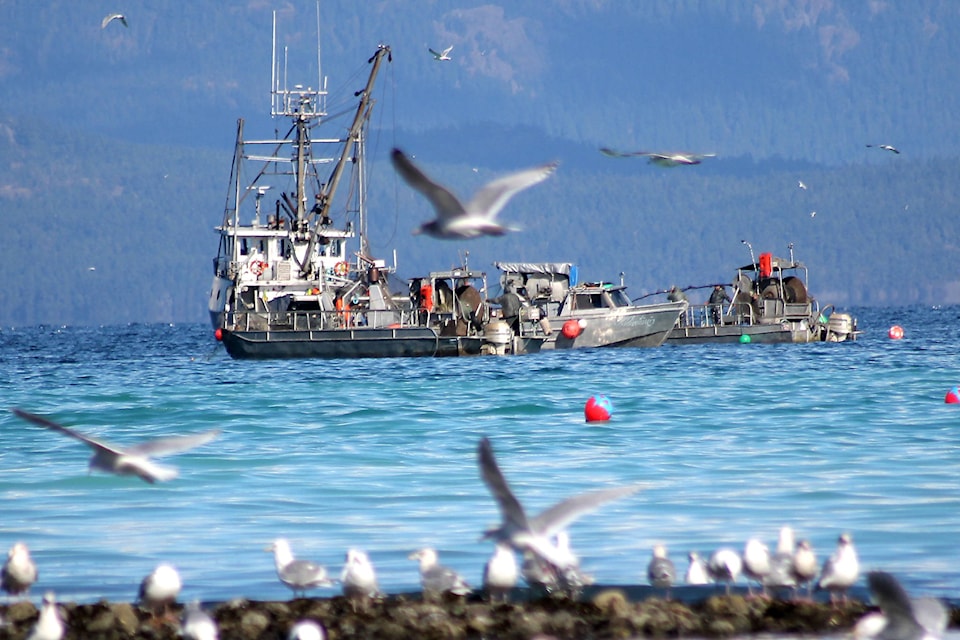Pacific fisheries are following a national downward trend of fewer healthy stocks, emphasizing an urgent need to diversify fisheries and for the federal government to follow through on neglected commitments to protect and restore critical populations, an independent audit shows.
Compiled by Oceana Canada using Fisheries and Oceans Canada (DFO) data, the audit notes the federal government has invested heavily in fisheries science, monitoring and management, including a modernized Fisheries Act, but it has not translated into action on the water.
“Out of 33 critical stocks, only six have rebuilding plans. A lot more are scheduled for the coming years, but at the rate we’re going it’s going to take 37 years to get through those plans, and that’s assuming no more stocks get into the critical zone,” Robert Rangeley, Oceana’s director of science said.
The audit focused on marine finfish, shellfish and other invertebrates but not fish that spend all or part of their life in freshwater, including salmon.
READ MORE: Anger growing among B.C. salmon anglers shut out of public fishery
Among the key findings, Oceana found only one-quarter of Canadian stocks are healthy, down 10 per cent since its first audit in 2017. Stocks of caution have risen from 16 to 19 per cent, while stocks in critical states have increased from 13.4 per cent to 17 per cent in the same time period.
The health of roughly one-third remains uncertain due to insufficient data, such as mortality estimates, which have been applied to only 20 per cent of stocks.
“We know why we have such poor fishing mortality estimates, because we do such poor fisheries monitoring,” Rangeley said. “If you don’t’ know the sources of the mortality, and you don’t know the extent of the mortality, you really can’t tell whether you should be backing off a fishery or not.”
Along B.C.’s coast the audit highlighted troubling decreases in crustaceans, the backbone of Canadian fisheries, and small forage fish that other commercially important fish prey upon.
“Herring, oolichan and other forage fish are so critically important to the ecosystem, as our Pacific First Nations know intimately well. But when we manage those stocks for commercial fishing … there’s no accountability for the stock’s role in the ecosystem,” Rangeley said. “So when quotas are set, they’re not set at a level that allows sufficient biomass to be left in the water for the other species that depend on them.
“Forage fish are worth twice as much in the water than they are in the net.”
In its recommendations, Oceana is now calling on the government to complete regulations that bring new Fisheries Act provisions into force, address inconsistencies in catch monitoring by implementing the national Fishery Monitoring Policy introduced in November 2019 and develop the remaining rebuilding plans.
Rangeley commended the government for several achievements in this year’s audit, including a rebuilding plan underway for critical Pacific herring stocks in the Haida Gwaii area, but cautioned completion of these plans is too often delayed or suspended.
No new rebuilding plans for critical stocks were released in 2020.
READ MORE: Open-net salmon farms on their way out of B.C. waters
An emailed statement from the office of Fisheries Minister Bernadette Jordan stated DFO welcomes the Oceana audit and will be reviewing the recommendations, but argued rebuilding plans are already a priority for the government.
“In 2018, our government modernized the Fisheries Act to restore protections to fish and fish habitat, and make fish stock rebuilding plans mandatory. Since then, DFO has completed rebuilding plans for six of nineteen selected stocks, and a further two have improved to the point where they are no longer in the critical zone. For the remaining priority stocks, DFO has specific fishery management measures in place, based on the best available science.”
The audit shows yelloweye rockfish of Vancouver Island jumped from critical status to healthy status in 2020, following an evaluation of rebuilding strategies.
The minister’s office added the government has taken consistent action, backed by targeted investments, to protect and restore species at risk and their habitats through many initiatives, including the Canada Nature Fund, the Ocean Protections Plan, the Coastal Baseline Fund, and the BC Salmon Restoration and Innovation Fund.
Rangeley praised DFO’s transparency and commitments but stressed the need for swifter follow through.
Oceana communicated with the department and elected officials to compile the audit, and shared the results before making them public.
“They’ve already validated it because they’ve gone over it with a fine-tooth comb,” Rangeley said. “There’s no argument about this audit, it’s the single-most important source for getting information on the status of our stocks and how we’re managing them. So give them credit for their transparency, and for making commitments. They know they’re falling short and they want to do better.”
He added the audit highlights the need to better diversify the species that are harvested, not just for better economic security of fishing communities, but also the government’s Blue Economy strategy, which will suffer without the backbone of sustainable wild fisheries.
